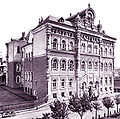Ippolito Monighetti

Ippolito Martin Florian Antonovich Monighetti ( Russian Ипполит Антонович Монигетти ; born January 5 jul. / 17th January 1819 greg. In Moscow , † May 10 jul. / 22. May 1878 greg. In St. Petersburg ) was a Russian architect and Watercolorist .
Life
Monighetti, son of the mason and businessman Carlo Antonio Monighetti from Biasca and his wife Vera Ivanovna born Gornostajewa, graduated from the Moscow shiny Stroganov - Drawing School . In 1834 he became a student at the Imperial Academy of Arts in St. Petersburg. His architecture teacher was Alexander Pavlovich Brjullow . In 1839 Monighetti received the Small Gold Medal for his theater school project. He could not take part in the competition for the Great Gold Medal due to illness. So he left the academy as an artist in the XIVth class and traveled to Italy to take care of his health . After a long stay, he went to Greece and the Orient to study and draw the architectural monuments. When he returned to St. Petersburg in 1847, he was accepted as a member of the Academy with his rich collection of architectural drawings. Some of his drawings then served the architecture class as teaching material.
Monighetti became the chief architect of the imperial castles in Tsarskoe Selo . His first building there was the Turkish bath in the style of a Turkish mosque. He then completed orangeries , he built two bridges in the park and built some stately dachas in the city. He then built houses in St. Petersburg for Count Novossilzew, Countess Apraxina, Prince Voronzow (on Moika ), Count Pavel Sergejewitsch Stroganow (on Sergejewskaja Ulitsa), Frau Nirotmorzewa and others. 1856–1857 he rebuilt the palace of Princess MW Voronzowa, which was rebuilt by Nicolas de Rochefort from 1895–1897 and taken over by the Lesgaft Institute for Physical Culture.
In 1858 Monighetti was appointed professor. He was now busy with projects for the construction of various buildings for the imperial dacha in Livadia in the Crimea . This also included an extremely graceful church in the Byzantine style . 1858-1860 he designed the interior of the Yusupov Palace on the Moika in St. Petersburg . In 1864 he worked out the project for the construction of a Russian Orthodox church in Vevey . Then he designed some state rooms in the St. Petersburg Anitschkow Palace , which was the residence of Crown Prince Alexander III. should be. This included a staircase in the style of Louis XVI. , a lounge in the style of Louis XIV and a library in the late Romanesque style. 1869–1873 Monighetti was busy with the luxurious interiors of the imperial yachts Derschawa and Liwadia . Other works by Monighetti included a stately home for Prince VI Barjatinski on his Kursk country estate, the renovation of the imperial palace in Skierniewice near Warsaw (where the Three Emperor's League was renewed in 1884 ) and the project to build a building for the Polytechnic Museum in Moscow. Monighetti was unable to complete this last project due to his serious illness.
Works
Dacha of the princess Sinaida Jussupowa , Tsarskoje Selo (Ippolito Monighetti, 1856)
literature
- Simona Martinoli: Ippolito Monighetti. In: Historical Lexicon of Switzerland . January 11, 2018 , accessed January 13, 2020 .
Web links
- Ippolito Monighetti Architect (Italian) on ti.ch/can/oltreconfiniti/dalle-origini-al-1900/vite-di-emigranti-e-discendenti/
Individual evidence
- ↑ Профессор архитектуры И. А. Монигетти, † . In: Всемирная иллюстрация . tape 19 , no. 489 , 1878, pp. 351 ( nlr.ru [accessed February 23, 2018]).
- ↑ a b c d e f g Монигетти (Ипполит Антонович) . In: Brockhaus-Efron . XIXa, 1896, p. 772-773 ( Wikisource [accessed February 23, 2018]).
- ↑ a b Simona Martinoli: Ippolito Monighetti. In: Historical Lexicon of Switzerland . January 11, 2018 , accessed February 23, 2018 .
- ↑ Citywalls: Архитектор Рошефор де Н. И., здания (accessed February 22, 2018).
| personal data | |
|---|---|
| SURNAME | Monighetti, Ippolito |
| ALTERNATIVE NAMES | Monighetti, Ippolito Martin Florian Antonowitsch (full name); Монигетти, Ипполит Антонович (Russian) |
| BRIEF DESCRIPTION | Russian architect and watercolorist |
| DATE OF BIRTH | January 17, 1819 |
| PLACE OF BIRTH | Moscow |
| DATE OF DEATH | May 22, 1878 |
| Place of death | St. Petersburg |






